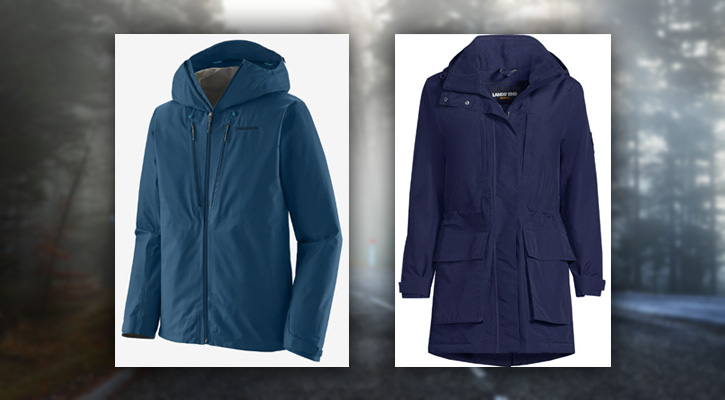
Whether you’re braving the great outdoors or just looking to keep cozy in the urban jungle, two iconic jacket brands demand your attention: Lands’ End and Patagonia.
But how do they really stack up against each other?
From the humble beginnings of Lands’ End as a sailing gear supplier to Patagonia’s roots in the climbing community, each has evolved to offer a line of jackets and other apparel that promise warmth, durability, and style.
But it’s not just about staying warm! It’s also about making choices that align with your values and needs.
In this side-by-side comparison, we’ll not only discover which jacket will protect you from the elements, but also which will best align with your lifestyle.
Contents:
1. Lands’ End Jackets
History of the Brand
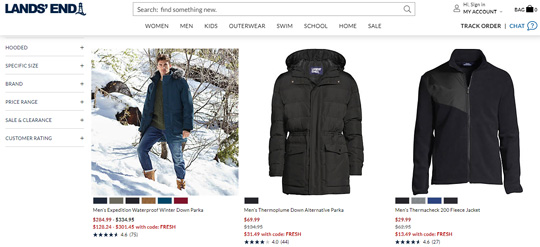
Lands’ End’s official website
Born in 1963, Lands’ End originated as a small mail-order company for sailing gear in Chicago. Founded by Gary Comer, a copywriter with a love for sailing and global exploration, the company began with Comer and four friends who shared his passion for sailing.
It took several years to establish the brand as a significant competitor within the industry, and by 1977, the business had reached the million-dollar mark. Lands’ End was among the first brands to adopt e-commerce as part of its mail-order operations and steadily broadened its product range to encompass not only yachting supplies but also clothing.
While there are now numerous Lands’ End stores, the brand mainly relies on its online retail presence.
Read also: 9 Brands like Lands’ End: Our Favorite Alternatives
Materials, Fabrics, and Production Process
Outdoor brands are increasingly shifting towards more environmentally friendly and sustainable production methods, and Lands’ End is no exception. They take pride in their advancements in this area and consistently strive to utilize responsibly sourced materials.
Nylon is primarily used for their weatherproof clothing, while cotton and polyester also play significant roles, particularly in outerwear and some accessories. Their insulating jackets primarily utilize natural down, known for its superior insulation properties.
Lands’ End ensures the humane treatment of birds by using only responsibly sourced down certified by the RDS. Additionally, the brand incorporates synthetic alternatives such as PrimaLoft for insulation.
The manufacturing facilities adhere to international standards and the brand’s own rigorous quality and employee treatment standards. For those looking to find out more about Lands’ End sustainability efforts, you can take a look here.
The video will be loaded from YouTube.com, a third party. If you play it, you accept their terms of service, and their use of cookies.
Read also: Lands’ End vs L.L. Bean Outdoor Gear: A Comparison
Where are Lands’ End jackets made?
Lands’ End manufactures its jackets and other apparel in the United States as well as in various other countries including China, Indonesia, and others.
Recommended Jackets
Lands’ End Men’s Expedition Waterproof Down Parka
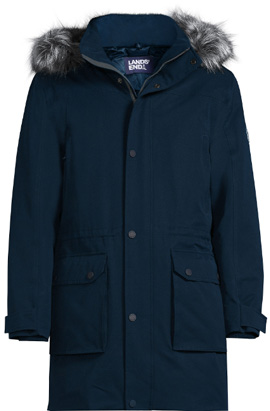
Image: landsend.com
Check it out at LandsEnd.com
The Expedition Waterproof Down Parka for men is an outstanding winter garment, specifically crafted for extreme winter conditions. Manufactured by a brand renowned for its expertise in addressing the challenges of harsh winters, particularly considering its base in Wisconsin, this parka showcases a 100% waterproof, seam-sealed outer layer to prevent rain and snow penetration.
The parka is insulated with 600-fill-power down, ensuring substantial warmth. With an extended length, the parka offers additional coverage and defense against the cold, effectively safeguarding the lower body from the elements.
It has many pockets, offering ample storage space for essentials. This parka is highly recommended for those residing in cold places, such as Wisconsin. The Expedition Parka is a top-quality option for anyone looking for reliable warmth during the cold winter months.
Don’t miss: Eddie Bauer vs Lands’ End: Which Brand is Better?
Lands’ End Women’s Squall Waterproof Insulated Parka
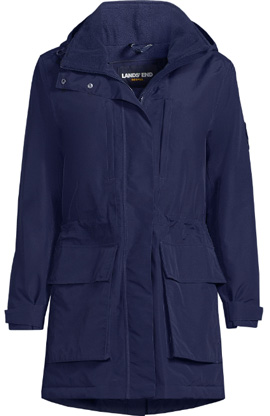
Image: landsend.com
Check it out at LandsEnd.com
The Women’s Squall Waterproof Insulated Parka is a specially crafted outerwear piece commemorating the 40th anniversary of the Squall line. Lands’ End has continuously refined this parka over four decades, incorporating customer feedback to introduce several new and enhanced features in the latest version.
The parka now includes updated zipper pulls for improved usability and more accessible pockets for added convenience. Additionally, reflective elements have been added to enhance visibility, for safety in low-light conditions.
This parka is engineered for various weather conditions, built from waterproof nylon fabric that not only repels wind and rain but also provides defense against snow. For warmth, the parka is insulated, and its extended length offers additional protection against the elements. The generous pocket space is also a practical feature.
Read also: Lands’ End vs Columbia Jackets: Which is Better?
Prices
Lands’ End offers a wide range of pricing options for its outerwear and activewear. The jacket pricing is quite varied, starting at $70, with some winter parkas that can cost upwards of $350.
Are Lands’ End jackets worth the price?
Lands’ End’s designs are of high quality and crafted from long-lasting materials. The cost of their jackets is justified in most cases for the quality you get in return.
Read also: Lands’ End vs The North Face Jackets: Which is Better?
2. Patagonia Jackets
History of the Brand
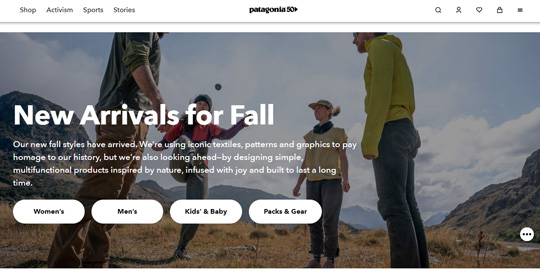
Patagonia official website
The origins of Patagonia can be traced back to 1957, when Yvon Chouinard, a climber and the company’s founder, started to pursue blacksmithing. In the same year, he built his first pitons, which he then marketed to fellow climbers.
Next, Chouinard set up a modest workshop in Burbank to produce his climbing gear. He would then transport these products in his vehicle, traveling throughout California to sell them.
In 1965, Chouinard entered into a partnership with Tom Frost, leading to the start of Chouinard Equipment. After the division of Chouinard Equipment, Yvon Chouinard founded Patagonia as a clothing brand in 1973.
Don’t miss:
9 Alternatives to Patagonia for Sustainable Outdoor Clothing
12 Best American Jackets and Outdoor Clothing Brands
Materials, Fabrics, and Production Process
Patagonia emphasizes the global impact of individual actions and integrates recycled materials, such as fishing nets, cashmere, wool, polyester, and cotton, into its outdoor gear and clothing.
The brand mostly utilizes Nylon and Polyester, along with advanced materials and fabric technologies like H2No and Gore-Tex, in their jackets and gear. Recycled down is employed for cold-weather insulation along with premium PrimaLoft synthetic insulation, and fabrics undergo thorough testing before use.
Patagonia is renowned in the outdoor community for its commitment to sustainability, fair labor conditions for its workers, and donations to environmental causes.
The video will be loaded from YouTube.com, a third party. If you play it, you accept their terms of service, and their use of cookies.
Read also: L.L. Bean vs Patagonia (Outdoor Gear Comparison)
Where are Patagonia jackets made?
Patagonia’s jackets, parkas, and outdoor equipment are mostly manufactured in China, Vietnam, Sri Lanka, Mexico, Thailand, and various other nations, with a minor portion produced within the USA.
Recommended Jackets
Patagonia Triolet Men’s Jacket
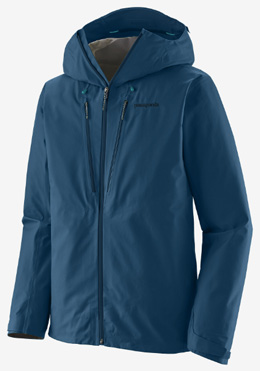
Image: patagonia.com
Check it out at Patagonia.com
The Triolet Men’s Jacket is built for cold, wet, and snowy conditions. Made from a 3-layer GORE-TEX fabric, it offers waterproof, breathable, and windproof protection, helped by a 100% recycled polyester outer shell.
This jacket is PFC-free and is made in a Fair Trade Certified factory. It has a helmet-compatible hood, two chest pockets with watertight zips, two front pockets, and an internal pocket. Next, it includes welted, watertight two-way pit zips for ventilation and a dual-adjust drawcord hem to block out the elements effectively.
With a concealed RECCO® reflector, the jacket is traceable while you’re out in the mountains. It’s made in Vietnam.
Read next: Canada Goose vs Patagonia Jackets: A Comparison
Patagonia Women’s Tres 3-in-1 Parka
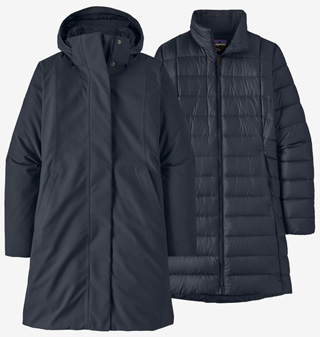
Image: patagonia.com
Check it out at Patagonia.com
The Women’s Tres 3-in-1 Parka by Patagonia offers adaptability to various weather conditions, serving as a waterproof shell, insulated jacket, or combined parka for more warmth. Crafted from sustainable, recycled materials such as polyester and 700-fill-power Recycled Down, it’s committed to eco-friendly and ethical manufacturing.
This parka is equipped with a two-way zipper, storm flap, detachable hood, and handwarmer pockets. It is designed for a regular fit, for easy layering, and extends above the knee for increased coverage.
Manufactured in a Fair Trade Certified™ facility in Vietnam and bearing the bluesign® approval, it follows high environmental and safety standards. Renowned for its functionality and resilience, it has earned positive feedback from users.
Don’t miss: Woolrich vs Patagonia (In-depth Jackets Comparison)
Prices
Patagonia is widely known as a premium company by outdoor enthusiasts. Their range of jackets and parkas usually begins at around $130 and can reach prices as high as $700.
Are Patagonia jackets worth the price?
We think that the jackets offered by Patagonia are a good investment, especially if you spend a lot of time outdoors. The company uses sustainable materials, is always advocating for environmental conservation, and delivers durable jackets that can last for years.
Learn more: Why Is Patagonia So Expensive and Popular? Are Its Jackets Worth It?
3. Which is Better?
Both brands can be good depending on what you need. Here’s what to keep in mind for an easier choice:
- Quality: Patagonia is generally considered of higher quality with more durable fabrics and construction. Their jackets tend to last longer with regular use. Lands’ End quality is good but not quite on the same level as Patagonia.
- Features: Patagonia jackets usually have more advanced technical features like waterproof and breathable membranes (H2No, Gore-Tex), insulated options, zippered pockets, etc. Lands’ End jackets cover the basics but may not have as many features as Patagonia.
- Styles: Lands’ End has a wider variety of classic casual styles suitable for everyday wear. Patagonia focuses more on active and outdoor designs.
- Sustainability: Patagonia is a leader in sustainable practices and using recycled and organic materials. Lands’ End has been improving but Patagonia has a longer track record in this category.
- Prices: Lands’ End jackets are more affordable on average. Patagonia has premium prices in many cases.
In the end, for technical and serious outdoor activities, we’d choose and recommend Patagonia. Lands’ End is a great option for casual outdoor clothing and city wear at more affordable prices.
Read next: 8 Sustainable Outdoor Clothing Brands that We Love!
